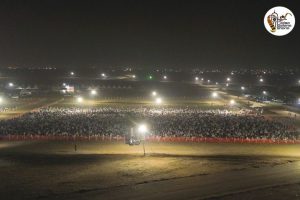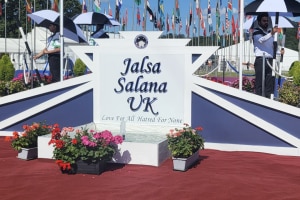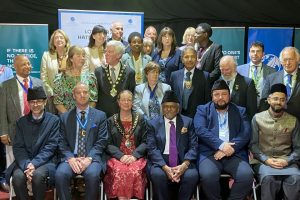
Every year, on the first day at the occasion of the Annual Convention (Jalsa Salana), the Caliph, Hazrat Khalifatul-Masih (aba) raises the official flag (Liwae Ahmadiyya) of the Ahmadiyya Muslim Community, known as the flag hoisting ceremony.
This practice is a key aspect of the Annual Convention, and thousands of people gather to witness it first-hand, whilst thousands more watch it on MTA. The importance of the raising of the flag can only be understood with an insight into the history of the flag itself.
History of the Flag
In 1939, some members of the Majlis-e-Shura [Consulting body of the community] presented a suggestion to the then Caliph, Hazrat Musleh Maud (ra), suggesting that in order to celebrate the 50th year of the establishment of the Ahmadiyya Muslim Community, and 25 years Jubilee of the Caliphate of Hazrat Musleh Maud (ra), an official flag of the community should be created and it ought to be raised at the occasion of Jalsa Salana by Hazrat Khalifatul-Masih.
This suggestion received both positive and negative feedback, the negative being that some members considered a flag to be a political representation of a country, which makes it an unsuitable suggestion. Hazrat Musleh Maud (may Allah be pleased with him) asked the scholars of the community to voice their opinion on this matter.
Hazrat Mir Muhammad Ishaac Ahmad sahib (may Allah be pleased with him) explained that once when the Holy Prophet (sa) went for the Eid prayer, a flag was raised to mark the occasion. Also, at the occurrence of Hajjatul Wida’ [the farewell pilgrimage] a flag was raised.

Hazrat Maulvi Syed Muhammad Sarwar Shah sahib (may Allah be pleased with him) stated that the Promised Messiah, Hazrat Mirza Ghulam Ahmad (as) saw in a vision that his community had a dedicated flag.
After hearing the opinions of these scholars, Hazrat Muselh Maud (may Allah be pleased with him) put the matter to a vote amongst the members of the Shura. In total, 376 members voted on this matter and in favour of the majority of the votes, Hazrat Musleh Maud (ra) authorised the creation of the flag.
Following the approval of the flag, members of the Shura presented their opinions with regard to the second matter; raising the flag at the occasion of the Annual Convention [Jalsa Salana]. After hearing their opinions, Hazrat Musleh Maud (ra) ordered the flag to be raised.
The historic task of preparing the original flag, from purchasing and gathering the required materials and sowing the flag together, to creating a wooden flag pole was assigned to specific male and female companions of the Promised Messiah (as). A committee was formed for this entire process, consisting of Hazrat Mirza Bashir Ahmad sahib M.A (may Allah be pleased with him), Hazrat Mir Muhammad Ishaac sahib (may Allah be pleased with him) and Hazrat Mirza Nasir Ahmad sahib (may Allah have mercy on him).
Finally, at the occasion of the Annual Convention in 1939, Hazrat Musleh Maud (may Allah be pleased with him) announced that raising a flag was not an innovation. The fact is that the Holy Prophet (peace and blessings of Allah be upon him) once prepared a flag and announced that this flag will only be given to that person who has a right to raise it. Hazrat Musleh Maud (may Allah be pleased with him) also heard the Promised Messiah (peace be upon him) state that we ought to have a flag, as it is sign of the gathering of people and it also creates passion in the hearts of the youth. He (peace be upon him) also stated:
‘My flag shall grant protection to all righteous people.’

Whenever we witness the flag hoisting ceremony, we ought to ponder over the context and insight of this great practise.
…………………………………………………..
About the Author: Daniyal Kahlon is a recent graduate of Jamia Ahmadiyya United Kingdom (The Ahmadiyya Muslim Community’s training seminary for missionaries).
…………………………………………………..




Add Comment